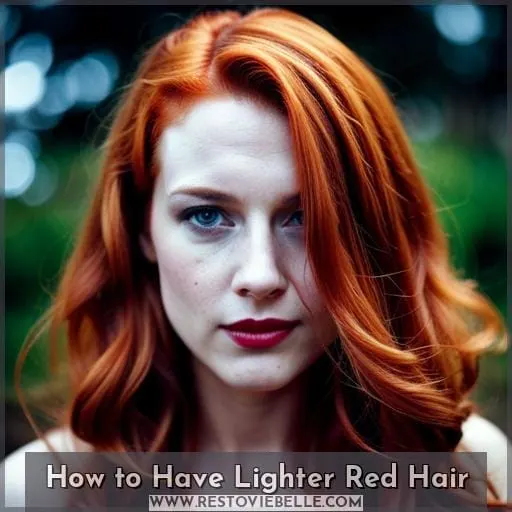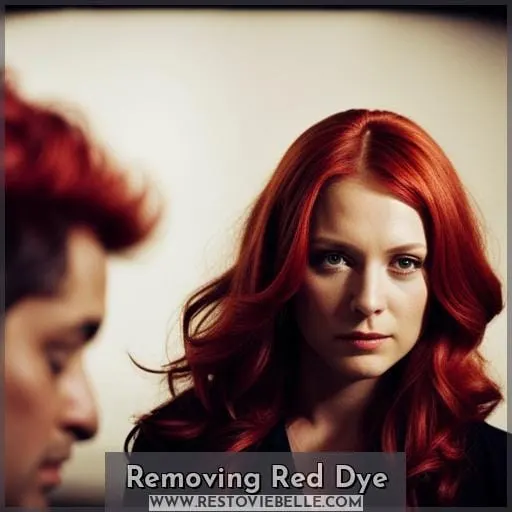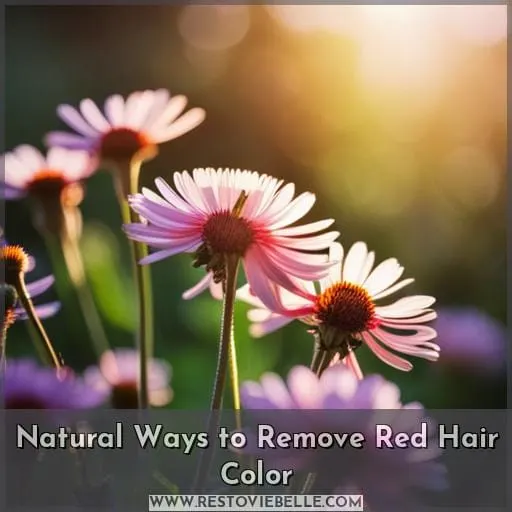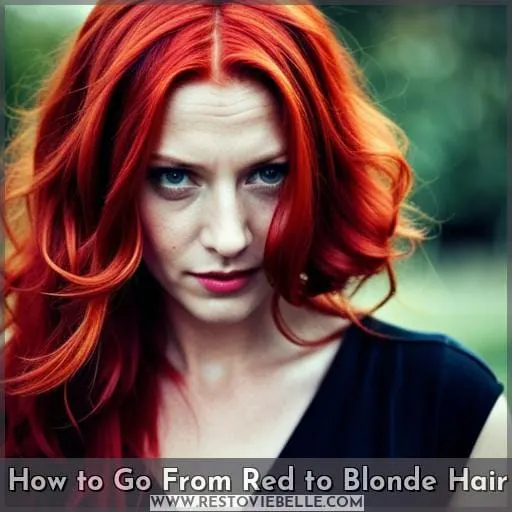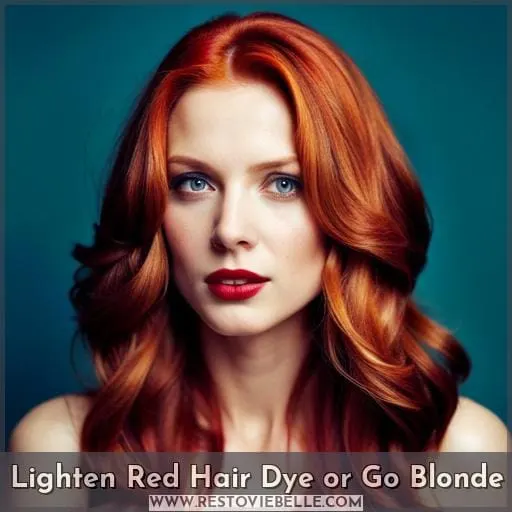This site is supported by our readers. We may earn a commission, at no cost to you, if you purchase through links.
 Do you often find yourself admiring the beauty of redheads? It’s no wonder why—according to a recent survey, 90% of people consider those with red hair attractive.
Do you often find yourself admiring the beauty of redheads? It’s no wonder why—according to a recent survey, 90% of people consider those with red hair attractive.
We’ll cover all the details so that when it comes time to make a decision about lightening up your hue, there won’t be any surprises. Let’s dive into permanent and semi-permanent dyes as well as natural ways like lemon juice and vinegar that can help remove unwanted shades.
Plus tips on how best go from darker tones back down the color wheel in order achieve salon-quality results at home without breaking the bank or causing too much damage in process.
Table Of Contents
- Key Takeaways
- What Happens if You Put Blonde on Red Hair Color?
- Understanding Hair Color Levels
- How to Have Lighter Red Hair
- Removing Red Dye
- Natural Ways to Remove Red Hair Color
- How to Go From Red to Blonde Hair
- Lighten Red Hair Dye or Go Blonde
- Blonde Semi-Permanent Dye Over Red Hair
- Know When to Consult a Professional
- Conclusion
Key Takeaways
- Transitioning from red to blonde hair requires careful planning and consideration.
- Permanent dye on red hair can result in orange or copper tones, so it is important to choose the right shade of blonde dye.
- Lighter red dye with a developer can be used for subtle changes before transitioning to blonde.
- Consulting a professional is recommended for major transformations to ensure the best results.
What Happens if You Put Blonde on Red Hair Color?
When it comes to changing your red hair color, you have two options: permanent dye or semi-permanent dye. Permanent hair dye lifts and deposits pigment, while semi-permanent only coats the strand. If you put blonde on red hair, the results may differ depending on which type of product you use.
Permanent Hair Dye
Using a permanent hair dye on red hair won’t turn it blonde, but it may result in orange or copper tones. Hair color levels indicate darkness and lightness. A lighter red dye with 20-30 volume developer can be used to make subtle changes.
If done right with caution and care, you’ll have beautiful results that will last until you decide upon another exciting hair journey!
Semi-Permanent Hair Dye
Try semi-permanent dye to give your hair an extra boost of vibrancy and a more subtle change in hue. Color Oops Hair Remover has been tested by users with positive results, restoring their hair to light pink shades without the use of bleach or ammonia.
Semi-permanent dyes only coat the strands and won’t significantly alter red hues.
Select lighter red dyes combined with 20 or 30 volume developers if you want a slight lightening effect on your current shade – but keep in mind this process takes time!
To achieve blonde tones from existing red, remove all pigment first using products like baking soda before bleaching carefully (with professional help).
Toner is essential post-bleach, as well as deep conditioning treatments, so get ready for some serious upkeep!
Understanding Hair Color Levels
When it comes to changing your hair color, understanding the different levels of hair color is key. Hair colors are typically classified into one of eight pigment levels on a chart ranging from 1 (black) to 8 (light blonde).
When transitioning from red to blonde dye, understanding these levels can help ensure that you get the desired shade.
Here are five tips for successfully using blonde dye on red hair:
- Familiarize yourself with common types of dyes, such as permanent and semi-permanent formulas, available in stores and salons.
- Consult a professional when considering bleaching services, as this process can damage your strands if done improperly.
- Research which type of pigment level best suits your desired outcome before selecting a product or service.
- Consider investing in toners after bleaching services in order to avoid brassy tones.
- Utilize conditioning treatments both before and after any chemical processes, such as dyeing or bleaching. This helps prevent further damage while maintaining moisture balance within each strand.
With careful planning and consideration for natural pigmentation, anyone looking for an updated look should have no problem achieving their ideal results!
How to Have Lighter Red Hair
If you’re looking to transition from red hair to something a bit lighter, there are several steps you can take. You can dye your hair using a higher-level (lighter) red, remove the existing red dye before lightening it, and then re-dyeing it with the desired color.
Doing this correctly requires patience and an understanding of how each step affects your results.
Dye Your Hair Using a Higher-level (lighter) Red
To lighten your red locks, try opting for a brighter shade of the same color; it’ll be like painting a new coat on an old canvas.
Semi-permanent dye won’t change red hair significantly, so you’ll need to lift the existing color with lighter red dyes and 20- or 30-volume developers.
Makeup can help complement this look and create exciting outfits.
You may also need to adjust your styling preferences as they may change due to this transition in hair colors.
To get blonde tones, remove all traces of the current dye first using a bleach bath or clarifying shampoo before bleaching properly.
Remove the Red Dye, Lighten Your Hair, and Dye It
If you want to achieve a lighter red hair look, consider removing the existing dye and lightening your hair before applying your desired shade. There are several techniques available, such as using bleach bath or color remover products.
You can also try natural methods like lemon juice, vinegar, or vitamin C to help fade red hair color faster. Make sure to follow the product instructions and conduct a strand test before bleaching to ensure safety.
After bleaching, use toner to neutralize brassy tones in blonde hair and deep conditioners to restore moisture to bleached locks.
With these tips in mind, you’ll have beautiful lighter red tresses that will turn heads!
Removing Red Dye
If you’re looking to lighten your red hair, a bleach bath or color remover are two options that may provide the desired result. Bleach baths lift and deposit yellow pigment, resulting in an orange hue on lighter red hair, while color removers can strip away permanent and semi-permanent dye without damaging the scalp or strands.
Both methods should be used cautiously, with proper precautions taken for best results.
Bleach Bath
A bleach bath is a chemical process that can lighten your locks without the need for multiple salon visits. It’s an alternative to using permanent or semi-permanent dye and helps with fading hair color from red to brown.
Blonde on red maintenance also requires special care regarding products used, as well as regular toning treatments. Natural methods, such as lemon juice or vinegar, may also be effective in removing some of the pigment from red hair.
Black dye over existing reddish hues can have various outcomes depending on how vibrant it was originally. Similarly, blonde dye will not make your strands go fully blond but rather introduce more yellow tones into them instead.
Consider all these options before attempting any major changes!
Color Remover
Try Color Oops Hair Remover for a quick and easy way to remove your red dye. It’s ammonia-free, bleach-free, and tested by many with positive results. If you’re looking for color correction or transformation from box dye mistakes, this product is ideal.
It can restore hair back to light pink after teal! Some users have reported drying effects, so deep conditioning afterwards is key.
Additionally, Color Oops Hair Remover can be used before applying lighter shades of red or blonde dyes over existing colors without lifting the underlying pigment first.
Natural Ways to Remove Red Hair Color
If you’re looking for natural ways to remove red hair color, lemon juice, vinegar, and Vitamin C are all excellent options. Lemon juice can be used on its own or mixed with other ingredients such as olive oil or honey to help lighten the hair without damaging it.
Vinegar helps strip away artificial dyes from your strands, while Vitamin C is often employed in combination with baking soda solutions to naturally lift the dye molecules out of the hair follicles.
Lemon Juice
Lemon juice can help fade red hair color, giving you an alternative to harsher methods. Applying lemon juice to the hair is a natural way of lightening and removing dye from your locks without using harsh chemicals.
Benefits include cost-effectiveness, easy availability, and minimal damage or drying effects on the scalp and ends of your strands.
Other DIY remedies for fading red tints are vinegar rinses, vitamin C treatments, and baking soda paste applications. These provide similar results but with different concentrations or ingredients added in depending on what result you’re looking for! Natural color fading techniques are non-damaging alternatives to further changing colors over red hair, such as bleaching when transitioning to blonde shades if desired.
Warm tones like browns may be achieved by using semi-permanent dyes. On the other hand, blue-black hues will require permanent tints that have been applied properly with all necessary precautions taken into account beforehand!
Vinegar
Vinegar can be used as an alternative to lemon juice to help fade red hair color. The benefits of vinegar are that it’s a natural product and helps restore the pH balance in your hair, making it less likely for future dyes to stick.
Vinegar also helps break down chemical bonds found in permanent dye molecules, leaving you with lighter shades of red on your hair. If you’re looking for DIY methods instead of using harsher removal products from the store or visiting a colorist, vinegar is an effective way to make adjustments without damaging your locks too much.
It’s important not to leave the mixture on too long, though, as this could cause fading beyond what was intended.
Vitamin C
Embrace the power of Vitamin C to help diminish red tones in your hair. You can lighten up those bright and vivid red hues by using vitamin C powder or tablets mixed with a mild shampoo.
Start off by making sure that your hair is properly conditioned prior to application. This will prevent any further damage caused by bleaching products like peroxide.
Massage the mixture into dampened strands and leave it on for 10-15 minutes, depending on how intense you want the effect to be.
With regular use, you can gradually reduce those brassy colors while strengthening weak locks at the same time.
How to Go From Red to Blonde Hair
If you’re looking to transition from red hair to blonde, you’ll need to take several steps. Conditioning your hair before and after any dye is key, as well as removing the existing red dye prior to bleaching.
To ensure a successful result when bleaching your locks, follow product instructions thoroughly and do a strand test first. Afterward, toners can be used for color correction, while deep conditioning helps restore moisture and nutrients in the strands of hair that have been damaged by bleach or other chemicals used in the process.
Condition Your Hair
Conditioning your locks is essential before and after bleaching to maintain hair health. Deep conditioning can help restore moisture, nutrients, and shine while preventing color fading. Styling tips, such as using clarifying shampoo or glosses, should be followed to enhance the results of your new blonde hair color.
Makeup matching with red tones also helps bring out the vibrancy of your new hue, as well as toning down brassy yellow undertones for a more natural look.
Remove the Red Dye
To transition from red to blonde, you’ll need to strip away the current dye first – it’s like pulling teeth! Red dye removal can be done with a bleach bath, color remover, clarifying shampoo, or baking soda.
Natural methods such as lemon juice and vinegar are also great for fading red hair. DIY-ers should always do a test strand before committing to using any method on their entire head of hair.
When attempting color correction at home, remember that bleaching must be done correctly following product instructions and doing a strand test beforehand.
Lastly, deep conditioning will help restore moisture and nutrients lost during the transformation process.
Bleach Your Hair Correctly
Before bleaching your hair, make sure to take all the proper precautions and follow product instructions closely. Ensure you’ve removed red dye at least a week before. Do a strand test ahead of time with bleach mixed according to manufacturer directions for an accurate result.
Here are some helpful tips:
- Use color-safe products beforehand.
- Mix bleach correctly using developer in a 1:2 ratio.
- Follow instructions carefully and monitor progress regularly.
- Rinse thoroughly when done and wait one week before coloring or styling again.
Tone Your Hair
After bleaching, make sure to tone your tresses for a perfectly polished look. Toning red hair is an important part of the transition from blonde to red hair. Color-depositing shampoos and conditioners are great for maintaining the color you desire.
However, toning can help neutralize brassy tones in blonde hair caused by oxidation.
Using sulfate-free shampoo helps protect against fading while adding shine and vibrancy back into strands that have been lightened or dyed. This is especially effective when paired with deep conditioning treatments. It’s important to follow product instructions carefully to avoid further damage or unwanted results.
With proper care and maintenance, transitioning from blonde to red can be achievable without sacrificing the health of your locks!
Deep Condition Your Locks
Rejuvenate your locks with a deep conditioner to replenish moisture and shine. A weekly deep conditioning session helps strengthen hair follicles, reduce frizz, and prevent split ends.
- Start by shampooing as normal.
- Apply the conditioner from mid-length to tips.
- Leave it in for 10 minutes or longer if desired.
- Rinse thoroughly until the water runs clear.
- Lastly, use a leave-in spray or serum to lock in moisture.
Deep conditioning is essential for a healthy hair care routine that keeps your locks looking vibrant and feeling soft! The natural oils help maintain elasticity while adding volume and protection against environmental damage too, all without weighing down strands! After each session of deep conditioning your locks, you’ll be left with softness, manageability, and beautiful luster.
Lighten Red Hair Dye or Go Blonde
Want to lighten your red hair dye or go blonde? It’s a significant change that requires careful preparation and maintenance.
Permanent dyes will lift color and deposit yellow pigment, resulting in an orange hue on red hair. Semi-permanent dyes only coat the strands, so if you’re looking for more of a dramatic transition, you’ll need to use lighter shades with 20- or 30-volume developer.
If you want even lighter results, consider removing any existing color before bleaching for the desired shade of blonde – just be sure to condition afterwards! There are DIY methods like lemon juice, vinegar, and vitamin C which may fade the color, but professional advice is always recommended when using bleach as it is quite harsh on your locks.
You can also opt for darker colors such as black or brown over existing red tones – ash blondes may reduce the vibrancy too – but whatever direction you choose, make sure it complements both your style and skin tone!
Blonde Semi-Permanent Dye Over Red Hair
If you’re looking to add some subtle lightness to your hair, consider trying a semi-permanent blonde dye. This will give you just the hint of color without drastically changing your look.
Here are five tips for using a blonde dye on red hair:
- Choose the right shade and developer strength for desired results. Lighter shades with 20 or 30 volume developers can lift red tones slightly but won’t overpower them.
- Use toner after bleaching if needed. This helps reduce brassiness in blonde hues while maintaining vibrancy in colored hair types like yours!
- Investigate natural methods such as lemon juice, vinegar, or vitamin C that may help fade existing colors safely before making any drastic changes to your locks.
- Make sure all products used are sulfate-free and color safe so they don’t strip away already existing hues from dyed strands!
- Protect yourself against damage by deep conditioning regularly both before and after the process.
With these tips in mind, take time exploring different styling options that suit best with the new hue – have fun experimenting until you find the perfect match between makeup choices plus personal style preferences!
Know When to Consult a Professional
Are you wanting to go from red to blonde hair but don’t know where to start? Consulting a professional is your best bet for achieving beautiful, healthy color results. DIY techniques may not always deliver the desired outcome and can even cause further damage or irreversible mistakes if improperly applied.
Professional guidance is especially important when attempting any major hair transformation such as transitioning from red to blonde. A good colorist will assess your current shade accurately, explain what’s needed for proper lightening/color correction, and how many sessions it might take before reaching the desired result.
To get started on achieving flawless locks without risking damage or permanent discoloration, find an experienced colorist near you that specializes in copper-to-blonde transformations today!
Conclusion
Making the transition from red to blonde hair can be a daunting process, but with the right knowledge and preparation, it’s possible. Blonde dye on red hair won’t turn it blonde; it may result in orange or copper tones.
Permanent hair dye lifts color and deposits yellow pigment, creating an orange hue on red hair.
To lighten red hair slightly, use a lighter red dye with a 20- or 30-volume developer. For achieving desired red shades, natural methods like lemon juice, vinegar, and vitamin C can be used to fade the red hair color.
If you’re looking for more significant changes, consider removing the red dye, lightening your hair, and applying the desired shade.
It’s important to plan carefully for your hair goals and reach out to a local colorist for personalized recommendations. With the right approach and dedication, you can achieve the blonde hair of your dreams.


